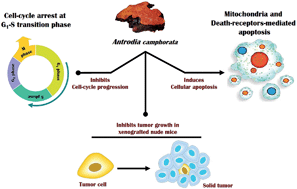Antrodia camphorata induces G1 cell-cycle arrest in human premyelocytic leukemia (HL-60) cells and suppresses tumor growth in athymic nude mice
Abstract
Antrodia camphorata is a well-known medicinal mushroom in Taiwan. The broth from a fermented culture of Antrodia camphorata (AC) has been shown to induce apoptosis in cultured human premyelocytic leukemia (HL-60) cells. In the present study, we examined the effects of AC on cell cycle arrest in vitro in HL-60 cells and on tumor regression in vivo using an athymic nude mouse model. We found that AC (20–80 μg mL−1) treatment significantly induced G1 cell-cycle arrest in HL-60 cells by reducing the levels of cyclin D1, CDK4, cyclin E, CDK2, cyclin A, and phosphorylation of retinoblastoma protein (p-Rb). Moreover, AC treatment led to significantly increased protein expression levels of CDK inhibitors, including p21WAF1 and p15NIK4B. Additionally, AC treatment markedly induced intracellular ROS generation and mitochondrial dysfunction in HL-60 cells. Furthermore, the in vivo study results revealed that AC treatment was effective in terms of delaying the tumor incidence in nude mice that had been inoculated with HL-60 cells as well as in reducing the tumor burden. Histological analysis confirmed that AC treatment significantly modulated the xenografted tumor progression as demonstrated by a reduction in mitotic cells. Our data strongly suggest that Antrodia camphorata could be an anti-cancer agent for human leukemia.


 Please wait while we load your content...
Please wait while we load your content...